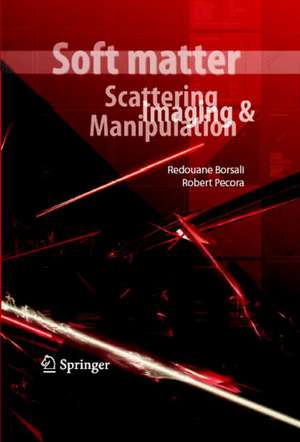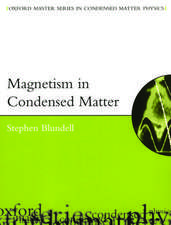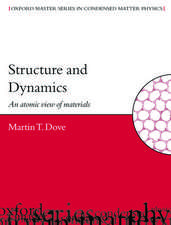Soft-Matter Characterization
Editat de Redouane Borsali, Robert Pecoraen Limba Engleză Hardback – 28 iul 2008
This will appeal to soft matter scientists at the graduate level and above, condensed matter physicists, chemists, biologists, medical doctors and engineers.
Preț: 2691.09 lei
Preț vechi: 3540.90 lei
-24% Nou
Puncte Express: 4037
Preț estimativ în valută:
515.01€ • 535.69$ • 425.17£
515.01€ • 535.69$ • 425.17£
Carte tipărită la comandă
Livrare economică 10-16 aprilie
Preluare comenzi: 021 569.72.76
Specificații
ISBN-13: 9781402044649
ISBN-10: 140204464X
Pagini: 1300
Ilustrații: LXXII, 1452 p. In 2 volumes, not available separately.
Dimensiuni: 155 x 235 x 74 mm
Greutate: 2.84 kg
Ediția:2008
Editura: SPRINGER NETHERLANDS
Colecția Springer
Locul publicării:Dordrecht, Netherlands
ISBN-10: 140204464X
Pagini: 1300
Ilustrații: LXXII, 1452 p. In 2 volumes, not available separately.
Dimensiuni: 155 x 235 x 74 mm
Greutate: 2.84 kg
Ediția:2008
Editura: SPRINGER NETHERLANDS
Colecția Springer
Locul publicării:Dordrecht, Netherlands
Public țintă
ResearchCuprins
Volume I:
Part I: Basic Concepts of Scattering.- Rod-like particles and Semi-rigid Polymers.- Theory of Polyelectrolytes.- Star Polymers and Dendrimers.- Micelles.- Brush-like Polymers.- Part II: Static Light Scattering.- Dynamic Light Scattering (DLS).- Light Scattering in Shear Fields.- Fluorescence Recovery After Photobleaching.- Forced Rayleigh Scattering (FRS).- Fluorescence Correlation Spectroscopy (FCS).- Dynamics of Block Copolymer disordered state: RPA approach. Light Scattering by Polysaccharides.- Gels.
Volume II:
Part III: Neutron Scattering: SANS.- SANS Liquid Crystal.- Adsorption of polyelectrolyte micelles as studied with neutron reflectivity and ellipsometry.- X-ray Scattering: SAXS/WAXS and ASAXS.- X-Ray (XPCS).- SAXS of Polyelectrolytes.- SAXS of Block Copolymer.- SAXS by Proteins.- Part IV: Imaging of Membranes (AFM).- Vesicles/micelles/rods and Imaging.- Polymers at Interfaces (AFM, etc).- Cryo-TEM.- Tweezers and Fluorescence microscopy.-Single Molecule Microscopy.- DNA Manipulation.- Brush-like Polymers.- Proteines/AFM.
Part I: Basic Concepts of Scattering.- Rod-like particles and Semi-rigid Polymers.- Theory of Polyelectrolytes.- Star Polymers and Dendrimers.- Micelles.- Brush-like Polymers.- Part II: Static Light Scattering.- Dynamic Light Scattering (DLS).- Light Scattering in Shear Fields.- Fluorescence Recovery After Photobleaching.- Forced Rayleigh Scattering (FRS).- Fluorescence Correlation Spectroscopy (FCS).- Dynamics of Block Copolymer disordered state: RPA approach. Light Scattering by Polysaccharides.- Gels.
Volume II:
Part III: Neutron Scattering: SANS.- SANS Liquid Crystal.- Adsorption of polyelectrolyte micelles as studied with neutron reflectivity and ellipsometry.- X-ray Scattering: SAXS/WAXS and ASAXS.- X-Ray (XPCS).- SAXS of Polyelectrolytes.- SAXS of Block Copolymer.- SAXS by Proteins.- Part IV: Imaging of Membranes (AFM).- Vesicles/micelles/rods and Imaging.- Polymers at Interfaces (AFM, etc).- Cryo-TEM.- Tweezers and Fluorescence microscopy.-Single Molecule Microscopy.- DNA Manipulation.- Brush-like Polymers.- Proteines/AFM.
Notă biografică
Redouane Borsali is Director of Research at the LCPO, a Polymer Research CNRS Laboratory, associated with the University of Bordeaux, France. He studied Physics at the University of Tlemcen, Algeria and received his Masters and Ph.D. in Polymer Physics at the Institute Charles Sadron (Louis Pasteur University, Strasbourg, France) in 1988. After his postdoctoral research position at the Max-Planck-Institute for Polymer Research (MPI-P) at Mainz, Germany in 1990 he joined the CNRS (Grenoble, France). In 1995, he spent a sabbatical leave at Stanford University and at IBM Almaden Research Center, CA, USA as a visiting scientist. He joined the LCPO in 2000 as the Polymer Physical-Chemistry Group Leader. His main research activities are focused on the study of the Structure, Dynamics and Self-assemblies of "Soft Matter" and particularly on Controlled Architecture Polymers such as block copolymers, polymer mixtures, polyelectrolytes, micelles, vesicles and rod-like particles. He is the author or co-author of over 110 research articles and two books.
Robert Pecora is Professor of Chemistry at Stanford University, USA. He received his A.B., A.M. and Ph.D. degrees from Columbia University, USA. After postdoctoral work at the Universite Libre de Bruxelles, Belgium and Columbia University he joined the Stanford University faculty in 1964. His research interests are in the areas of condensed phase dynamics of small molecules, macromolecules and colloids of both materials and biological interest. He is one of the major developers of the dynamic light scattering technique and has used many of the other techniques described in these volumes. His research emphasis is now on liquids near the glass transition, rigid rod polymers, polyelectrolytes and composite liquids. He is the author or co-author of over 130 research articles and five books.
Robert Pecora is Professor of Chemistry at Stanford University, USA. He received his A.B., A.M. and Ph.D. degrees from Columbia University, USA. After postdoctoral work at the Universite Libre de Bruxelles, Belgium and Columbia University he joined the Stanford University faculty in 1964. His research interests are in the areas of condensed phase dynamics of small molecules, macromolecules and colloids of both materials and biological interest. He is one of the major developers of the dynamic light scattering technique and has used many of the other techniques described in these volumes. His research emphasis is now on liquids near the glass transition, rigid rod polymers, polyelectrolytes and composite liquids. He is the author or co-author of over 130 research articles and five books.
Textul de pe ultima copertă
Progress in basic soft matter research is driven largely by the experimental techniques available. Much of the work is concerned with understanding them at the microscopic level, especially at the nanometer length scales that give soft matter studies a wide overlap with nanotechnology.
This 2 volume reference work, split into 4 parts, presents detailed discussions of many of the major techniques commonly used as well as some of those in current development for studying and manipulating soft matter. The articles are intended to be accessible to the interdisciplinary audience (at the graduate student level and above) that is or will be engaged in soft matter studies or those in other disciplines who wish to view some of the research methods in this fascinating field.
Part 1 contains articles with a largely (but, in most cases, not exclusively) theoretical content and/or that cover material relevant to more than one of the techniques covered in subsequent volumes. It includes an introductory chapter on some of the time and space-time correlation functions that are extensively employed in other articles in the series, a comprehensive treatment of integrated intensity (static) light scattering from macromolecular solutions, as well as articles on small angle scattering from micelles and scattering from brush copolymers. A chapter on block copolymers reviews the theory (random phase approximation) of these systems, and surveys experiments on them (including static and dynamic light scattering, small-angle x-ray and neutron scattering as well as neutron spin echo (NSE) experiments). This chapter describes block copolymer behavior in the "disordered phase" and also their self-organization. The volume concludes with a review of the theory and computer simulations of polyelectrolyte solutions.
Part 2 contains material on dynamic light scattering, light scattering in shear fields and the related techniques of fluorescence recovery after photo bleaching (also called fluorescence photo bleaching recovery to avoid the unappealing acronym of the usual name), fluorescence fluctuation spectroscopy, and forced Rayleigh scattering. Volume 11 concludes with an extensive treatment of light scattering from dispersions of polysaccharides.
Part 3 presents articles devoted to the use of x-rays and neutrons to study soft matter systems. It contains survey articles on both neutron and x-ray methods and more detailed articles on the study of specific systems- gels, melts, surfaces, polyelectrolytes, proteins, nucleic acids, block copolymers. It includes an article on the emerging x-ray photon correlation technique, the x-ray analogue to dynamic light scattering (photon correlation spectroscopy).
Part 4 describes direct imaging techniques and methods for manipulating soft matter systems. It includes discussions of electron microscopy techniques, atomic force microscopy, single molecule microscopy, optical tweezers (with applications to the study of DNA, myosin motors, etc.), visualizing molecules at interfaces, advances in high contrast optical microscopy (with applications to imaging giant vesicles and motile cells), and methods for synthesizing and atomic force microscopy imaging of novel highly branched polymers..
Soft matter research is, like most modern scientific work, an international endeavor. This is reflected by the contributions to these volumes by leaders in the field from laboratories in nine different counties. An important contribution to the international flavor of the field comes, in particular, from x-ray and neutron experiments that commonly involve the use of a few large facilities that are multinational in their staff and user base.
This 2 volume reference work, split into 4 parts, presents detailed discussions of many of the major techniques commonly used as well as some of those in current development for studying and manipulating soft matter. The articles are intended to be accessible to the interdisciplinary audience (at the graduate student level and above) that is or will be engaged in soft matter studies or those in other disciplines who wish to view some of the research methods in this fascinating field.
Part 1 contains articles with a largely (but, in most cases, not exclusively) theoretical content and/or that cover material relevant to more than one of the techniques covered in subsequent volumes. It includes an introductory chapter on some of the time and space-time correlation functions that are extensively employed in other articles in the series, a comprehensive treatment of integrated intensity (static) light scattering from macromolecular solutions, as well as articles on small angle scattering from micelles and scattering from brush copolymers. A chapter on block copolymers reviews the theory (random phase approximation) of these systems, and surveys experiments on them (including static and dynamic light scattering, small-angle x-ray and neutron scattering as well as neutron spin echo (NSE) experiments). This chapter describes block copolymer behavior in the "disordered phase" and also their self-organization. The volume concludes with a review of the theory and computer simulations of polyelectrolyte solutions.
Part 2 contains material on dynamic light scattering, light scattering in shear fields and the related techniques of fluorescence recovery after photo bleaching (also called fluorescence photo bleaching recovery to avoid the unappealing acronym of the usual name), fluorescence fluctuation spectroscopy, and forced Rayleigh scattering. Volume 11 concludes with an extensive treatment of light scattering from dispersions of polysaccharides.
Part 3 presents articles devoted to the use of x-rays and neutrons to study soft matter systems. It contains survey articles on both neutron and x-ray methods and more detailed articles on the study of specific systems- gels, melts, surfaces, polyelectrolytes, proteins, nucleic acids, block copolymers. It includes an article on the emerging x-ray photon correlation technique, the x-ray analogue to dynamic light scattering (photon correlation spectroscopy).
Part 4 describes direct imaging techniques and methods for manipulating soft matter systems. It includes discussions of electron microscopy techniques, atomic force microscopy, single molecule microscopy, optical tweezers (with applications to the study of DNA, myosin motors, etc.), visualizing molecules at interfaces, advances in high contrast optical microscopy (with applications to imaging giant vesicles and motile cells), and methods for synthesizing and atomic force microscopy imaging of novel highly branched polymers..
Soft matter research is, like most modern scientific work, an international endeavor. This is reflected by the contributions to these volumes by leaders in the field from laboratories in nine different counties. An important contribution to the international flavor of the field comes, in particular, from x-ray and neutron experiments that commonly involve the use of a few large facilities that are multinational in their staff and user base.
Caracteristici
The only book covering the whole field A comprehensive treatment of the major techniques for studying soft matter at the nanoscale level Accessible to an interdisciplinary audience Includes supplementary material: sn.pub/extras

















